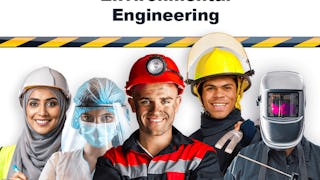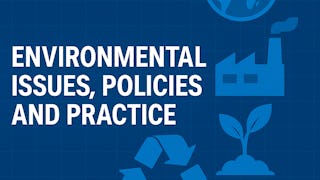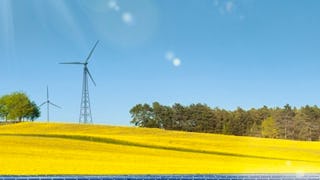Master comprehensive environmental knowledge from Earth's ecosystems to sustainable solutions. This course equips you to understand the environmental crisis, analyze biodiversity loss, climate change, and resource depletion, and apply circular economy principles for sustainable development.



Environmental Studies

Instructor: BITS Pilani Instructors Group
Access provided by The National Institute of Engineering
Recommended experience
What you'll learn
Analyze ecosystem dynamics, biogeochemical cycles, and biodiversity patterns to understand environmental systems and conservation needs.
Evaluate climate change science, planetary boundaries, and UN Sustainable Development Goals for environmental decision-making.
Apply circular economy principles, Life Cycle Assessment, and Environmental Impact Assessment to sustainability challenges.
Develop sustainable solutions by integrating environmental knowledge with business practices, policy frameworks, and conservation strategies.
Skills you'll gain
- Environmental Resource Management
- Biology
- Environmental Science
- Climate Change Adaptation
- Natural Resource Management
- Environmental Policy
- Environmental Monitoring
- Climate Change Programs
- Climate Change Mitigation
- Environment
- Sustainable Business
- Systems Thinking
- Environmental Issue
- Water Sustainability
- Pollution Prevention
- Waste Minimization
- Sustainable Development
- Stakeholder Engagement
- Environmental Management Systems
Details to know

Add to your LinkedIn profile
November 2025
See how employees at top companies are mastering in-demand skills

There are 10 modules in this course
This module covers the origin of life on Earth, the rock cycle, water cycle, phosphorus cycle, nitrogen cycle, and sulfur cycle. It also illustrates various concepts of ecosystems and their interactions with the environment, including the carbon and nitrogen cycles. Additionally, by the end of this module, students will have learned to compare and contrast food chains and food webs.
What's included
17 videos19 readings16 assignments
This module entails a comprehensive exploration of ecosystem components and the pathways of energy flow within ecosystems. Key concepts in environmental studies will be summarized, including ecosystem productivity, community interactions, keystone species, ecosystem regulation, carrying capacity, and ecological niches. Students will also examine the dynamics of food chains and food webs, understand the importance of biodiversity, and assess the impact of human activities on ecosystems.
What's included
10 videos12 readings12 assignments
We begin this module by defining a biome and comparing biomes and ecosystems. We then classify different types of biomes which include Temperate Deciduous, Tropical Evergreen Forests, Grasslands, Deserts, Chaparral, Tundra, Taiga, High Mountains, and aquatic biome and their key features.
What's included
7 videos7 readings9 assignments
This module highlights by explaining biodiversity and various methods to measure it. We then describe biogeographical classification and correlating it with world scenario. Further students will be able to identify key mega-diversity nations and hotspots of biodiversity on earth. A comparison on endangered and endemic species will be done. Various methods of biodiversity conservation will be discussed and correlated to special projects for conservation of endangered species in biodiversity.
What's included
8 videos10 readings10 assignments
This module will provide students with knowledge about natural resources and classify their types which include forest, water, mineral, food, and land. Further, the module will provide a comparison between renewable and non-renewable resources. At the end of this module, students will be able to correlate the effects of the depletion of natural resources on the environment.
What's included
10 videos10 readings12 assignments
Climate change and global warming are often used interchangeably but have distinct meanings. Likewise, “climate” and “weather” are often used in the wrong places. In this module, we will study what these terms mean, what “climate change” means, what its consequences are, and how we can best mitigate the problem and/or adapt to the new normal.
What's included
11 videos12 readings13 assignments
Human activities have impacted our environment to such an extent that scientists are now debating whether we ought to have a separate epoch! In this module, we learn about the planetary boundaries framework, a set of nine processes that regulate the stability and resilience of the earth system. We appraise the latest updates, key publications, policy and practice applications and news related to this concept.
What's included
10 videos10 readings12 assignments
The SDGs are an urgent call for action by all countries in a global partnership. In this module, we study each goal and note the status of each goal nation-wise. We evaluate the UN-SDGs for efficacy in the context of the escalating environmental crisis and make suggestions for the emerging global sustainable development paradigm.
What's included
10 videos10 readings12 assignments
The circular economy is an alternative to traditional linear economies, where we take resources, make things, consume them, and throw them away. In a circular economy, products are used again and again, minimizing our use of raw materials and cutting CO2 emissions. Embracing circularity benefits the planet, our economies, and our communities. Environmental Impact Assessments (EIAs) play a crucial role in sustainable development and informed decision-making. EIAs safeguard communities, ecosystems, and our planet by ensuring responsible development practices. Life Cycle Assessment (LCA) is a systematic methodology used to evaluate the environmental impacts of a product, process, or service throughout its entire life cycle.
What's included
12 videos12 readings14 assignments
In this module, we discuss a few key case studies and mitigation strategies related to the current environmental crisis. Some of these case studies throw light on important environmental concerns and include topics like pesticide toxicity, land subsidence, radiation damage, and garbage islands in the ocean. Others lead the way by illustrating how solutions can sometimes come from unexpected quarters - from elephant tracking drones to indigenous seed saviours, to plastic recycling innovators, … to ordinary people doing their bit. We learn to fix the bugs in our environment by fostering critical thinking, problem-solving, and decision-making in real-world contexts.
What's included
10 videos11 readings12 assignments
Instructor

Why people choose Coursera for their career




Explore more from Physical Science and Engineering

Khalifa University

O.P. Jindal Global University

Dartmouth College

Dartmouth College
¹ Some assignments in this course are AI-graded. For these assignments, your data will be used in accordance with Coursera's Privacy Notice.

